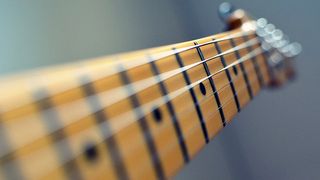So, if you don’t know your nuts from your neck, and your licks from your pick-ups, then read-on. Learning a new musical instrument is tough, especially as you need to decipher a whole new set of terms too. We’ve started by breaking down different parts of the guitar, then detailed the terms needed for playing, and listed the accessories and additions you’ll come across too. If you’re looking to get a handle on the music-side of things, the best music notation software (opens in new tab) will help you with this too.
Parts of the Guitar
Headstock: The top part of the guitar that has the tuners attached to it.Tuners: (Pegs) The knobs on the headstock that can be adjust the pitch of the string.Nut: A small section between the headstock and the neck with tiny grooves that guide the string up to the tuners.Neck: (finger board, fret board) The long section between the nut and the body of the instrument.Body: (sound box) The large portion of the guitar. In acoustic, classical and some steel guitar this section is usually hollow. In electric guitars, this part is usually solid.Bridge: Attached to the body, this piece of hardware anchors the other end of the strings.Pick ups: Electric guitars have a small piece that is attached to the body under the strings, this “picks up” the sound of the played strings.Fret: This word has two meanings. It can refer to the space on the neck between the horizontal metal strips or it can refer to the strips themselves.
Electric Guitar Accessories
Processor: An electronic device that can alter the sound of the guitar. Often takes the place of the old-fashioned distortion pedal, usually these can be operated by the foot and offer many effects.Amplifier or Amp: Similar to a speaker, this device projects the sound from an electric guitar; some have multiple adjustments or the ability to do some distortion.Pedal: Often called a distortion pedal, effects pedal or pedal board, this device can be turned on and off by the foot and it has the ability to change the sound of the guitar.Cable: Connects guitar to amp, processor or distortion pedal.Capo: A device that has the ability to hold down all of the strings, essentially shortening the string length to change the sound.
Other Common Words
Gig Bag: An alternative to the traditional hard guitar case, it is usually a soft case that protects the guitar when traveling.Pick: A tool usually made of nylon, that is held by the thumb and index finger that is used to stroke the strings.Strap: Attaches to the head and the body of the guitar and is used to ‘strap’ the guitar onto the player.Distortion: Changes the sound of the guitar, if you “add distortion” you put the sound through a processor or distortion pedal to the change the sound. You can also distort the sound by hand techniques.Power Chord: Not really a chord, but a series of roots and 5th without any 3rd. Has a powerful and solid sound.Riff: A piece of music, often called a musical statement, which repeats throughout a song as a main theme.Lick: A short, often ad-libbed piece of music, usually used as filler and not as the main theme.Reverb: Can be added with a stomp box, processor or through an amp to give the music a more natural sound.Feedback: An annoying squeal or hum that occurs when the loop between an input and output device is closed. Often can be fixed just be moving the instrument or some use an equalizer or other control device.
With a few pieces of choice vocabulary under your belt, you can go hang out with the band, read a concert review and maybe even understand what’s being said, or - yeah - maybe learn the guitar for yourself.
